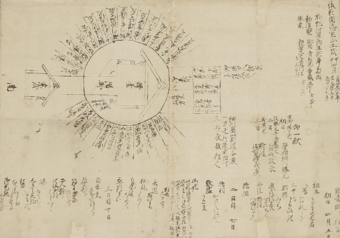「糺勧進能」とは
 「寛正五年糺河原勧進猿楽図」(観世文庫所蔵)糺河原勧進猿楽は、今から約550年前の寛正五年(1464)に将軍足利義政をはじめとする錚々たる大名の前で行われた猿楽興行です。後の観世流隆盛の契機となったこの一大イベントの様子は、「寛正五年糺河原勧進猿楽図」として観世宗家に大切に伝えられてきました(右図)。これまであまり注目されてきませんでしたが、桟敷に並ぶ諸大名の配置からは当時の権力構造が一目でわかる上に、橋掛りが舞台の後方に描かれるなど、多くの点で興味深い貴重な史料です。賀茂御祖神社では、永く、この糺の地における猿楽興行の再興が検討されてまいりましたが、いよいよ、本年五月、現在の観世大夫である二十六世観世宗家により「糺勧進能」としての再興が実現する運びとなりました。
「寛正五年糺河原勧進猿楽図」(観世文庫所蔵)糺河原勧進猿楽は、今から約550年前の寛正五年(1464)に将軍足利義政をはじめとする錚々たる大名の前で行われた猿楽興行です。後の観世流隆盛の契機となったこの一大イベントの様子は、「寛正五年糺河原勧進猿楽図」として観世宗家に大切に伝えられてきました(右図)。これまであまり注目されてきませんでしたが、桟敷に並ぶ諸大名の配置からは当時の権力構造が一目でわかる上に、橋掛りが舞台の後方に描かれるなど、多くの点で興味深い貴重な史料です。賀茂御祖神社では、永く、この糺の地における猿楽興行の再興が検討されてまいりましたが、いよいよ、本年五月、現在の観世大夫である二十六世観世宗家により「糺勧進能」としての再興が実現する運びとなりました。
今回の再興においては、史料に基づき、本殿から舞台中央へ真っ直ぐに橋掛りを架ける初の試みをいたします。また、この一日限りの舞台で行われる演目は「賀茂」。まさに賀茂の御祭神が舞台奥の本殿より立ち現れ、また本殿へと戻っていくことになるでしょう。祈りの芸能である猿楽(能楽)の根源に立ち戻るかのような感動を与えてくれるのではないかと期待しています。
さて、550年前の猿楽興行は「勧進」として行われました。建物の造営や修理のために寄附を集める「勧進」という名目の下、芸能興行が行われたのです。その意味でも、賀茂御祖神社の二十一年に一度の遷宮の年に、勧進猿楽が再興されることは、大きな意味があると考えています。
世界文化遺産の森と社殿を未来へと引き継いでいくためには、どうすればよいのでしょうか。時代は移り変わり、二十一年に一度の遷宮も容易ではありません。世界無形文化遺産に制定されている能楽もまた、今や人々にとって身近な存在であるとは言えない状況です。
一方で、いま日本文化は世界からおおいに注目を集めています。自然に生かされ、祈りのなかに育まれてきた日本の素晴らしい文化を未来へとつないでいくために、「勧進猿楽」の再興は重要な鍵を握ることになるかもしれません。能楽堂ではない、屋外ならではの舞台。うつろう空の下、森を抜ける風と能の声が響きあい、木霊しあうことでしょう。
実現に向けて、一人でも多くの方々に足をお運びいただき、またご協力をいただきますように、お願いいたします。
糺猿楽再興実行委員会
糺猿楽再興 よびかけ人
千 玄室 石田隆一 梅原 猛 柏原康夫 増田正蔵 佐藤茂雄
立石義雄 塚本能交 平井義久 堀場 厚 松岡心平 村田純一 (順不同)
About the Tadasu Kanjin Noh
Tadasugawara Kanjin Sarugaku was a theatre performance, organized in 1464 by the Shogun Ashikaga Yoshimasa, for some of the most important political leaders of that time. This event became one of the reasons for the great success of what is now the Kanze school of noh. A historical document called the “Diagram of Tadasugawara Kanjin Sarugaku in the Fifth Year of Kansho Era” (see chart on the right) has been passed down in the Kanze family ever since.
So far there hasn't been much research done on this document, yet it shows us some very interesting historical facts. For example, by examining the seating position of each of the Daimyos (feudal lords), we can clearly see the structure of political force of that era. Also, the “hashigakari” (a bridgeway to the noh stage), which is usually located on the left side, is drawn on the back of the stage.
Shimogamo shrine has been wishing to make a revive the tradition of noh in the Tadasu area for many years. This year, thanks to Kanze Kiyokazu, the 26th grand master of the Kanze school, we can at last witness the comeback of this great performance.
In order to bring the performance as close to the historical event as possible, a hashigakari will be built at the back of the stage, leading from the main shrine building. The main part of the performance will be the play Kamo, featuring the deity of the Shimogamo shrine. We will actually witness the deity appear from the shrine, and then return back at the end, which will take us back to the very roots of noh, when it used to be a religious ritual.
550 years ago, the Tadasugawara Kanjin Sarugaku was held for the purpose of temple solicitation, meaning that it was done in order to raise funds for a construction and renovation of a temple. We find it very symbolic to hold the event in the year of Shimogamo shrine's renovation.
Shimogamo shrine and its sacred forest are registered as the UNESCO World Heritage. As the times change, we feel the urge to think of new ways to protect this very special place, as it is getting increasingly difficult to follow the ancient tradition of shrine renovation.
While being an Intangible Cultural Heritage, noh theatre nowadays also seems to be somewhat far from people's daily lives.
On the other hand, Japanese culture has recently been gathering a lot of attention from all over the world. Kanjin Sarugaku might be one of the keys to protecting this precious traditional culture, which was born and raised from prayer and reverence of nature.
In this outdoor performance, we can enjoy noh in harmony with nature, seeing the sky change, feeling the wind, hearing the echo of the sound from the nearby forest.
We would be delighted to see as many viewers as possible, and also would like to ask for your kind support.
Committee for the revival of Tadasu Sarugaku
